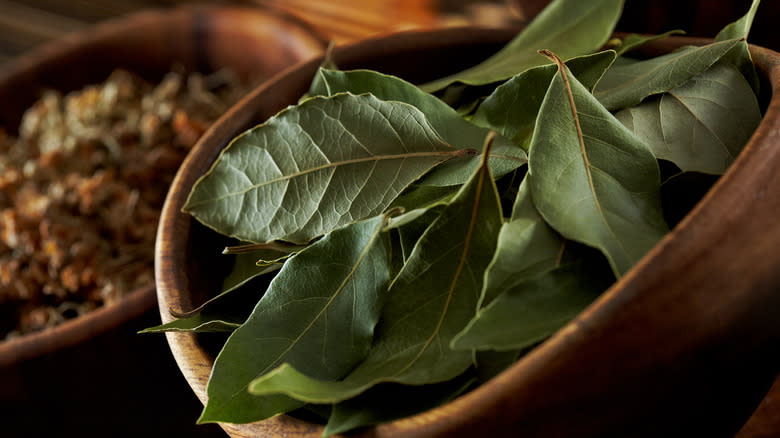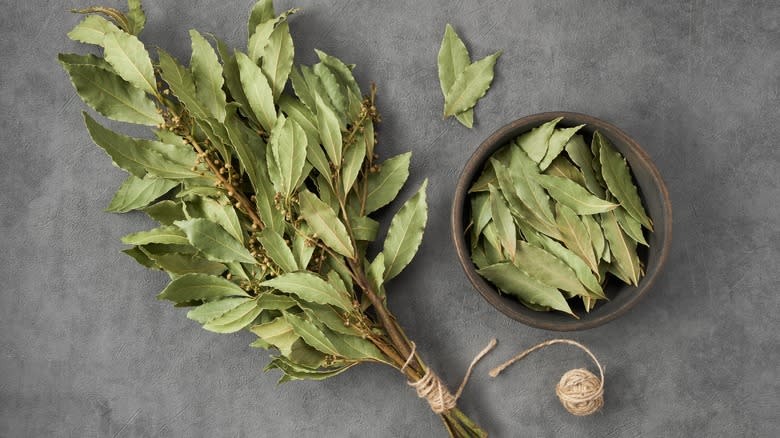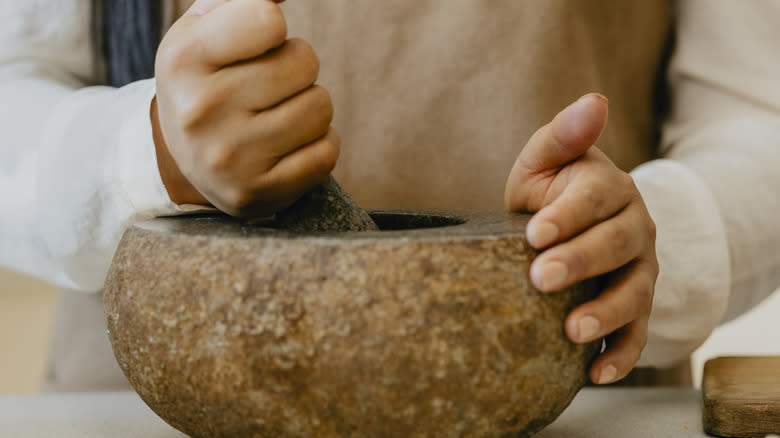When Cooking With Bay Leaves, Should You Ground Them Into Powder?

The humble bay leaf is no stranger to the average pantry or spice rack. Several types of bay leaf are cultivated globally, but today's most well-known variety, the Turkish bay leaf, is grown in the Mediterranean. The dried bay leaf's seemingly subtle presence can help craft a creamy ravioli, gently infuse an aromatic dhal, or softly permeate a beef stew with herbal depths and floral undertones. The bay leaf is generally employed in a stiff, dried whole-leaf state, but have you ever pondered the idea of grinding them into a powder?
Dried bay leaves can be ground at home, and can also be purchased pre-ground. However, whether you should or not is entirely up to your taste buds and flavor preferences. The profiles of a bay leaf are softened as they cook in hot liquids, like stews or sauces. Once a bay leaf is ground, like many ground herbs and spices, its flavor is accentuated. As a result, if you're planning to use it in a recipe, it must be used lightly and sparingly. Recognize that its ground form will permeate and infuse every part of the dish with this more defined flavor.
Exploring how you can use ground bay leaves and what kinds are available may indicate whether this culinary avenue is really for you. Let's get to the grind.
Read more: 13 Tips To Make Your Shrimp Taste So Much Better
Why You Should Use Ground Bay Leaves

Ground, dried bay leaf is an under-appreciated addition to rubs, aromatic dishes, or spice mixes. Ideally, if a recipe calls for a whole bay leaf, you can experiment with substituting this for the ground variety -- try replacing one leaf with ⅛ to ¼ teaspoon of ground. When just starting down this path, you may be surprised by how pungent ground bay leaf can be, so remember that less is more.
A simple rub of pepper, salt, and ground bay leaves would beautifully complement a roasted chicken stuffed with lemons. The woody fragrance of the ground leaves adds depth to the succulent chicken as it roasts. Ground bay leaves could also bring herbal elements to a sweet and spicy rub made with brown sugar and cayenne. This kind of rub would beautifully intensify the flavor of rich, juicy pork chops or a savory beef pot roast.
Should You Ground Them Yourself?

Grinding bay leaves at home can be a particularly laborious process. If you've ever been unfortunate enough to devour a whole bay leaf that's been accidentally left in a dish, you'll understand why. Their dried form is stiff, rigid, and almost unchewable. In this regard, it's essential to grind the leaves into the finest powder because any coarser, and the pieces will add a grainy texture to the dish. This consistency can be reached in a spice grinder, although it may take some persistence.
If you want to further explore how to cook with bay leaves, it's handy to recognize the subtle flavor differences in the types of leaves available. Fresh bay leaves are particularly bitter, while dried ones are aromatically herbal. Mediterranean bay leaves carry more menthol notes, while Indonesian bay leaves are a great choice for the pantry since they are earthy, subtly sweet, with gentle bitterness. The universe of bay leaves is diverse and rich. You only need to take a step into this realm and see where the culinary adventure takes you.
Read the original article on Daily Meal.

